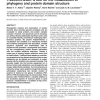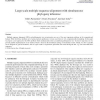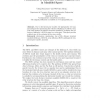JCB
1998
13 years 4 months ago
1998
Abstract. The method of invariants is an approach to the problem of reconstructing the phylogenetic tree of a collection of m taxa using nucleotide sequence data. Models for the re...
JCB
2007
13 years 4 months ago
2007
Given a phylogenetic tree for a family of tandemly repeated genes and their signed order on the chromosome, we aim to find the minimum number of inversions compatible with an evo...
TCBB
2008
13 years 4 months ago
2008
Reconstruction of phylogenetic trees is a fundamental problem in computational biology. While excellent heuristic methods are available for many variants of this problem, new adva...
NAR
2006
13 years 4 months ago
2006
Phylogenetic analysis and examination of protein domains allow accurate genome annotation and are invaluable to study proteins and protein complex evolution. However, two sequence...
JPDC
2006
13 years 4 months ago
2006
Multiple sequence alignment (MSA) and phylogenetic tree reconstruction are one of the most important problems in the computational biology. While both these problems are of great ...
BMCBI
2006
13 years 4 months ago
2006
Background: With current technology, vast amounts of data can be cheaply and efficiently produced in association studies, and to prevent data analysis to become the bottleneck of ...
BMCBI
2006
13 years 4 months ago
2006
Background: The problem of inferring the evolutionary history and constructing the phylogenetic tree with high performance has become one of the major problems in computational bi...
BMCBI
2006
13 years 4 months ago
2006
Background: Phylogenetic analyses of protein families are used to define the evolutionary relationships between homologous proteins. The interpretation of protein-sequence phyloge...
BMCBI
2007
13 years 4 months ago
2007
Background: Alternative representations of biochemical networks emphasise different aspects of the data and contribute to the understanding of complex biological systems. In this ...
ACIIDS
2010
IEEE
13 years 5 months ago
2010
IEEE
Due to the lateral gene transfer, the phylogenetic tree may be inadequate for representing the evolution of Influenza A (H1N1) virus. This work employs the distance invariant manif...





